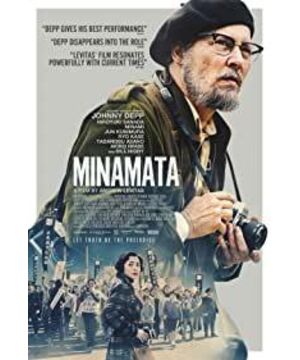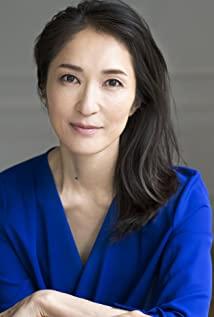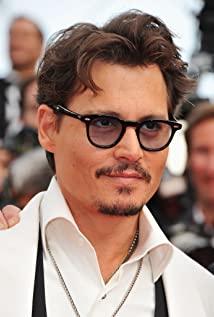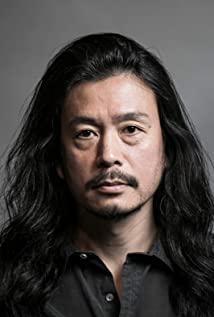20200220. Berlin Film Festival "Minamata Disease" premiere in the media field on the eve.
Eugene Smith himself is a Van Gogh-like figure. His works are out of the circle, and his character is out of the circle, so even passers-by will prefer him. If his own story is as super five-star as his most handed down works, then this movie is at most a three-star level, and it also depends on Johnny Depp's character bonus + the story itself The power of reality is too strong (but even if it is Samsung, it is still worth watching, after all, it is Eugene's story, after all, it is played by Depp). Naturally, the director came to carry the blame. There is nothing else, but the level is not enough, the story is told without any waves, and all the characters are on the surface. Watching the actors want to exert their strength but can't find the point of exertion is really anxious. Both the photography and the soundtrack have some memory points, but after playing such a good card, there are only leggings left to cover it up. It can only be said that it is really a pity that Eugene's story is not directed by the master.
As far as actor performance is concerned, Johnny Depp is probably the active player who is most competent for Eugene in terms of age, temperament, and character control ability. He is a godly choice. Personally, I like the part of him holding Tomoko in the film (no spoilers), which is bright and moving. Another highlight is Ryo Kase, and the other characters (including Bill Nighy) have little room to play. Mistress just. . . I can see that I tried my best, but I didn't call Depp, I didn't call at all, and I didn't show the charm and contribution of Erin Smith in reality. Not choosing a heroine who can catch Depp's drama and spark sparks with him may also be the second biggest failure after the director.
The reason why I have this feeling is because I interviewed Erin Smith (who is prettier than the heroine) by chance in 2010. At that time, it was the 39th World Environment Day. He came to Beijing to give a speech on the topic of "Century", and exhibited works related to Eugene Minamata. Ten years later, for the first time, I saw the person I interviewed become a character in the movie, and it was still played by Depp.
Beginning in 1971, 21-year-old Erin began to film together with Eugene Smith in Minamata for three years, recording the endless harm caused by industrial pollution to humans and the environment. During this period, the world's most famous film was born. A picture of environmental victims "Tomoko in the Bath". In the next 50 years, from reporters and photographers to volunteers and teachers, Irene has been engaged in a variety of work related to the environment. She has been committed to solving environmental problems and has become one of the Japanese environmental movement important facilitator. So she herself is by no means a "vase" like in the movie, and listening to her and Eugene's story in Japan may be the best way for us to get close to the legendary master now.
Before watching this film, I re-read the interview manuscript "Eugene Smith's Darkroom Girl" and read it again. Later, I found that many details in the film were restored in place. After checking again, Irene herself really participated. The screenwriter team, she hid her memories of Eugene into the details of the movie like private goods. The interview from 10 years ago seems stupid and gossip now, but some clips can match the film and follow Erin's point of view to get closer to Eugene.
Q1: You were born in Tokyo, when did you start living in the United States for a long time?
Aileen: My dad is American and my mom is Japanese. Since I was two years old, I have been going back and forth between the United States and Japan, about ten times. I have been living in Saint Louis since I was 11 years old, and then I went back to Japan for a year of high school. In 1968, he was admitted to Stanford University in the United States. The first two years of university are not divided into majors. At that time, many Americans opposed the Vietnam War, and there were many student movements, and I also participated in such movements. Before the start of my junior year, I was going to choose Southeast Asia History as a major to continue my studies, but because of Eugene, I dropped out. In 1971, I returned to Japan with Eugene to shoot in Minamata, Kumamoto Prefecture.
Q2: Did the ideological trends and various movements around the world in 1968 inspire you to become interested in photojournalism?
Aileen: There should be such a factor. I have been to many Asian countries when I was a child, and there is a stark contrast between the poverty and the United States, so I have a deep sense of the gap between the rich and the poor since I was a child. When I was in high school, I went to Saigon, which was during the Vietnam War. It was probably because of the Vietnam War that I started to pay more attention to politically relevant expressions. But before meeting Eugene, I didn't think that art or photography could have such a big impact on people.
Q3: Did you start photography at that time?
Aileen: No, I remember when I was in college I had a camera but hardly ever took pictures - I didn't know how to load film, so I threw it away.
Q4: You don't understand photography? So how did you get the chance to be an assistant at the Eugene Smith Photography Exhibition?
Aileen: It was 1970, and I was working on a summer work project for Dentsu, and the client was FUJIFILM. The job was to shoot a TV commercial featuring two famous photographers, Eugene being one of them. My job is to translate and coordinate the communication between the Japanese staff and Eugene. So I went with the camera crew to Eugene's home in New York. After a week of work, I'm going back to college in California. Eugene is preparing for a major exhibition of 600 of his works, a selection of his oeuvre up to that time. He handled almost everything by himself, was completely overwhelmed, and the exhibition was delayed. He begged me to stay and help, so I stayed and helped him do this exhibition together - which is why I decided to drop out.
Q5: Do you remember the first time you met Eugene? (PS: This part is restored in the movie)
Aileen: Remember, remember. I went with my Japanese colleagues on the crew to Eugene's Manhattan residence, which used to be a clothing factory that was later abandoned. The lower level of the attic is a small shop selling hardware such as axes and hammers, and the whole house is very old and very old, and there is a lot of dust. My Japanese colleague and I went upstairs, and when we pressed the button, the Japanese colleague said, "Maybe we're in the wrong place," but my gut feeling was, "It's here, there's nothing wrong." Then the door opened and Eugene was standing there before us. My Japanese colleague greeted him with something like "what a great photographer you are" and I translated it to Eugene who asked me, "Great? Did you hear my name before you came? ", I said it honestly: "No, I haven't heard your name", and he laughed. Before preparing for this work, I didn't know him as a photographer at all, and I didn't see his works, even the most famous "The Walk to Paradise Garden" (also known as "To Paradise Garden" at that time. ”) have not seen it either.
Q6: How did you feel when you saw Eugene's photo in such a comprehensive way for the first time?
Aileen: Actually, Eugene's work itself had a far less impact on me than what he expressed to me - he told me what he wanted to express through his work, what his intentions were, what his beliefs were. Eugene kept telling me about his beliefs in photography and journalism, such as when he resigned from Life magazine because he was unhappy with the way they used images. In the exhibition of 600 works, Eugene displayed 125 pictures on Schweitzer's subject, each of which is a masterpiece.
Q7: Eugene often talks to people about his understanding of photography and journalism?
Aileen: Yeah, he's always saying that to people, from the beginning to the end. Some are difficult to understand. For example, in that exhibition, many people did not understand the name of the exhibition "Let Truth Be the Prejudice". Because Prejudice (prejudice) is a derogatory term, but Eugene said: Everyone has a prejudice, but I hope that in our world, everyone's prejudice can be closer to the truth. However, because the name was too difficult to understand, when I did this exhibition in Japan later, the name was changed to "Truth is a Friend" (the truth is a friend).
Q8: Do you agree with his ideas?
Aileen: Yes. Maybe the first time he said it, it was hard to understand "Is it really so?", but gradually I found it very powerful. For example, Eugene believes that photography cannot be objective; photography is responsible for both the subject and the person who sees it; the nuances between "neutrality" and "fairness"... Maybe I was "brainwashed" "Well, I'm not sure (laughs).
Q9: What was your specific job at that time?
Aileen: Coordinated production, framing, and installation, including assisting Eugene in developing and enlarging photographs. I had absolutely no training in this area before this, and that was my beginning.
Q10: Do you also help with printing? Did Eugene teach you? (PS: This paragraph also has a similar restoration clip in the movie)
Aileen: Yes, I not only learned to print, but also learned to "observe". I started by watching how Eugene developed and imitating him. When he was printing, he would take a spoon, block here, cover there, make this side darker and that side brighter, and after 7 or 8 times, I knew by observation, "Oh, there should be more here, There should be less there." So one time when Eugene was taking a break, I said to him "I want to do one too" and printed out my first photo with the details I remembered - I I was delighted that the first photograph I developed in my life was included in Eugene's final exhibition. But at the time I was just "copying" Eugene's actions, it doesn't mean I can flush. But I think it's important to learn that there are actually no steps to learning. You must learn something first and then learn something later. Eugene also thinks so, he never says: You are a beginner, what can be done and what cannot be done. The situation at the time was that if I needed to do anything, I had to hurry up and learn what to do now.
Q11: What was Eugene's state at that time?
Aileen: When I met Eugene, he was very depressed, he always said he would kill himself when he finished the exhibition. But what's interesting is that he is always joking, every day.
Q12: Eugene really always talks about "suicide"?
Aileen: Yes, yes, he always jokes, but also always says he's going to kill himself. Before Eugene and I were together, he would often call his biographer Jim Hughes and say, "I'm so depressed, I'm going to kill myself," and Jim usually answered the phone and Go over with him and make sure he's okay. But once, when Eugene said he was going to kill himself, Jim said "Okay, you go!" (laughs) - Eugene certainly didn't actually kill himself, but he wasn't lying. This was his real emotion, he was really depressed, he did have this thought, but he didn't kill himself. When I was going back to school, Eugene begged me to stay, saying that if I left him and went back to California, he would kill himself. I didn't know about those things before, and I ended up believing him completely, so I stayed. Maybe it's his way of begging for help, he's actually saying "Help me!" - help me, or yes, help me.
Q13: You said Eugene always likes to joke, do you still remember his jokes?
Aileen: He always plays on homophones or puns. For example, Eugene is from Kansas, and Kansas has a lot of grain, and the adjective for grain is corny, but it also means "stupid" - Eugene always said he was corny from Kansas - -Very bored? He was like a child a lot of the time (laughs), and he liked to pull us up to "dance".
Q14: I heard that you like dancing. Is Eugene's "dance" a genre that you like?
Aileen: Haha, no, no, he just "dances", not "dances". Eugene's darkroom is not quiet, there is always music playing. A lot of times he would dance around with the music and dance with me. Jazz, rock, opera. Eugene was very into music, and back then we would play Bob Dylan, Miles Davis, Giuseppe Verdi's La traviata (La Traviata), Pucci G. Giacom Puccini's La Bohème (Bohemians) and more.
Q15: In Eugene's "Mr. Mercy", Dr. Albert Schweitzer once said that "there are two ways to get rid of myths in life, that is, cats and music." Eugene also likes cats?
Aileen: Yes, Eugene has a cat named "Taiho" in New York. Taiho was a very famous sumo wrestler in Japan in the 1960s. He always had a dreamy expression, but he was very powerful. Eugene liked him very much and called his cat "Taiho". Eugene often tells me what his cats used to be like. His home in New York is really messy and dilapidated, and it is more suitable for warehouses than living. Even the city inspector (presumably similar to those from the housing management office or neighborhood committee in China) said that "this place is really not suitable for living." In the end, even a cat mother couldn't stand it, so she gave Eugene a "meow" and ran away with the baby cat (laughs).
(ps: Eugene Smith died in 1978, at the age of 59, with only $18 left in the bank at the time of his death. At 7:00 that morning, he went to the deserted street to find his lost cat, Accidentally fell, bumped his head, and died of a cerebral hemorrhage.)
Q16: In 1971, after the exhibition of 600 works by Eugene was completed, how did you come to Japan to start the Minamata project?
Aileen: My Japanese friend Kazuhiko Motomura wanted to bring Eugene's exhibition to Tokyo, so we went to Japan. At that time, there were already many people in Japan who supported Minamata patients, and Motomura was one of them, so he told us what happened in Minamata. After arriving at Minamata, we rented two rooms, one for ourselves and one for the darkroom. The house that was used as a darkroom was originally occupied, and it was about to collapse. It was a "dangerous house".
Q17: Where do you live, how many percent of the local villagers are victims?
Aileen: We went to the place where Minamata disease was the most serious. In 1971, about 10% of the villagers had the disease. More and more people are getting sick gradually, and now more than 70% of the people are applying for official recognition of Minamata disease.
Q18: Is what you saw after arriving at Minamata the same as what you imagined before you went?
Aileen: We have seen the movie "Minamata Disease Patients and Their World" by Noriaki Tsuchimoto (Minamata--Patients さんとそのWorld), and we have a general idea. When we got to Minamata, we were told that there was no Minamata disease there - and that was what the scientists told us. But we photographed what we actually saw, which is what you see. A lot of people have asked me if I was shocked to be there. It was shocking at first, but then Eugene and I actually lived there, with the people there, and it felt completely different—there was our life.
Q19: How many photos did you take from 1971 to 1974?
Aileen: I can't remember. About 1,000 copies per year, 3,000 copies in three years? Probably. Eugene usually uses more than three cameras at the same time. At Minamata, he used two Minolta, a Leica and a Nikon (details here in the movie). I didn't study photography professionally, and I don't even remember Eugene teaching me how to do it. I mainly shoot every day, and I naturally learn it.
Q20: You took one-third of the final photographs in the book "Minamata Disease" (co-authors W. Eugene Smith, Holt Rinehart, Winston, 1975
Aileen: Yes, Eugene's is still in the majority. If I don't look at the pictures now, there are some pictures that I can't remember who took them.
Q21: Do you and Eugene have a division of labor in taking pictures?
Aileen: I don’t recall that we had a formal discussion about how to take pictures, what to take today, what to take tomorrow, how to behave, etc. Of course there will be communication. For example, when we go to a place to take pictures together, there will be different perspectives. It's just that at that time, I didn't feel that Eugene was the "commander" of the project. I didn't feel very lonely until I wrote a book on my own. It turned out that it was quite difficult to present the whole thing perfectly. That's when I realized that Eugene had been leading things. Maybe you don't think he did anything, but things are going on the track he laid. It's just that I didn't realize this when I was in Minamata.
Q22: How was Eugene's state when you were in Minamata?
Aileen: Eugene would be very slow and meticulous every day preparing what he needed for the next day's shoot, and his whole focus was on those things. He doesn't even remember the phone number at home, so he needs me to help with the chores of life. But as long as you are in photography, or in the darkroom, you will see that Eugene is so focused. When it comes to choosing from a very large number of negatives, I may watch a lot of them and think, "This is good, that is good too", but Eugene always finds the one he needs most at once: "This is it!" It's amazing, because when Eugene was taking pictures, he didn't give off a particularly strong "I'm here to take a good picture" feeling. Sometimes you will feel that he is not particularly well prepared, or even knows what he is doing. He himself says that he is like a mouse, jumping back and forth between here and there - in fact, he is a "Tai Chi master", as long as He shoots and always hits his target. Eugene was influenced a lot by music, rather than painting, he was more sensitive to music. The negatives in his darkroom, like the beat of the music, may start out slowly, then the rhythm gradually intensifies, and finally there are two big drum beats, and then slowly slide down. When the strongest rhythm appears, he can feel "This is it! This is it!"
Q23: Do you still play music in Minamata's darkroom?
Aileen: It does, but we don't have a lot of records there, but we do. It just can't be as loud as in New York, because it will disturb the surrounding villagers.
Q24: Eugene always had a hard time. How was your time in Minamata?
Aileen: Things weren't that expensive in Japan at that time, so you didn't need to spend too much money. The landlord grows his own vegetables, but his wife has been hospitalized. Sometimes we help out and bring some vegetables. We also go fishing a few times, and the landlord will give us some fish. The most fixed daily expense is to buy whisky for Eugene, which is about $2.50. We live super close to the whisky shop, and we can buy it back in about a minute and a half.
Q25: Can Eugene still take pictures and use a darkroom after drinking alcohol?
Aileen: (laughs) No problem. He is a big alcoholic. He has been drinking since the morning, drinking one bottle a day. It is estimated that he is indeed alcohol dependent. He's been drinking since I met him, but I've only seen him drunk once. When Eugene went to a lecture, he would bring a teacup. Others thought it was tea, but it was actually wine. Then he talked and drank.
Q26: Do you also drink with him?
Aileen: No no no. Now I like cats, but I still don't like alcohol, haha.
Q27: Is the place where you lived in Minamata still preserved?
Aileen: It was torn down four years ago. (circa 2006)
Q28: Do you still visit there often?
Aileen: Yes, several times. When my daughter was young, I went back about once every three or four years, but now I usually go once a year. I often see victims of Minamata disease in Tokyo, and last year I followed the victims in wheelchairs to protest in front of the Cabinet Office. Our work back then could not relieve the pain of the victims, but we could show their pain to the world. There is a strong community culture in Minamata where people support each other.
Q29: Do you and Eugene have any religious beliefs?
Aileen: I have no religious beliefs myself. Eugene, who was Catholic as a child, left his home state of Kansas when he grew up, and dropped out of teaching when he went to New York. But I feel that the doctrine of original sin, redemption, etc. in Catholicism still has a great influence on Eugene-Eugene thinks he is like a "martyr" (martyr), taking the lead and covering the body of horses-but he was no longer religious at that time. .
Q30: Or can it be understood that the things you do are your beliefs?
Aileen: Maybe. Many people may not understand what we do, but we still work hard and fight for it.
Q31: Do you believe in fate?
Aileen: (laughs) Maybe. If I hadn't gone to Minamata with Eugene, maybe he would have shot there anyway, but I don't know if my life would have gone the other way. In Minamata, although what we saw was suffering, life there gave us a lot of joy, and it was the best year of my life.
Q32: Is Eugene more suitable for work, and it is more difficult to get along with people once he leaves the work environment? So after leaving Minamata and going back to New York, you ended up leaving him?
Aileen: Many people separate work and life, but Eugene is different, his work and life are mixed together. It was his emotions, his family, his place, inseparable - they were one and the same thing. We are not workaholics, that so-called "job", like our children, is an emotional need. Eugene said he was not a good dad, his eldest daughter wrote a poem on his tombstone called "The Phone": "Dad is always on the other side of the phone" - I don't remember the details of the poem, But the gist of it was that she really wanted her dad to be around, but he wasn't always there. I also have a daughter, and while I've been working on the environment for so many years, I've been balancing work with family and kids -- but Eugene couldn't, he couldn't handle it.
Q33: In 1978, a few months after you left Eugene, he died. Did you go to his funeral?
Aileen: I have to go. A total of five women attended Eugene's memorial service, Eugene's first wife, me (second wife), the mother of one of Eugene's children, a girlfriend of ten years, and at the end The girl who took care of him during the day. Eugene's name on his tombstone, his two children, his first wife and me -- but we're both divorced from him.
Q34: After that, will you visit him often?
Aileen: In 32 years, I've never seen Eugene in a cemetery.
Q35: Why didn't you go to see him again?
Aileen: Well...it's a bit strange to say, Eugene's home is not far from New York, about four hours' drive...but it's been 32 years since he left...I'm always busy, busy with work , to New York, to Japan, to Minamata, to take care of my children... But I have been thinking about this issue for the past two years, and I think I should go see him. After Eugene left, I was married and had a daughter. But for me, Eugene never left, he was by my side, in my heart, not in that cemetery. But in recent years, every time it's his birthday or the anniversary of his death, I often think that the part of his cemetery is very cold and snows, maybe I should bring flowers to see him - maybe, just I haven't been there yet. I was thinking about it the last time I went back to New York, but there were a lot of media interviews, the schedule was so full, it was so busy... maybe that's why.
Q36: Did Eugene have any time to "entrust your dreams" to you?
Aileen: Yes, yes. Two years ago (2008), I did an exhibition in Kyoto, Japan, which was also Eugene's work on Minamata, and there were some works that had never been shown before. The day before the show, Eugene appeared in my dream, and he stood outside the showroom and said to me, "Let's go in!"
Q37: After Eugene left, you worked as a photojournalist focusing on environmental pollution in Japan; in 1981, you worked as a teaching assistant in the Department of Environmental Science, School of Public Health, Columbia University; Work - these are the same things you did with Eugene earlier. Is this choice because of your own love for it, or because of Eugene's influence on you?
Aileen: I chose to study environmental science at the Columbia University School of Public Health because I wanted to understand how companies or industries use science to “play tricks” to oppress victims and deny them legitimate rights. I think there should be someone who understands these things and can further help the victims and give them the rights they deserve. I never wanted to be a government official related to public health, I just wanted to do my part to help people in need. It can be said that I inherited Eugene's spirit, but I am not doing anything for him. I haven't been a photojournalist all the time, and I'm not involved with the Eugene Smith Humanitarian Photography Awards. Of course, I have paid attention to this award, and I know that Chinese photographer Lu Guangguang won the 30th award.
Q38: There is a saying in China, "It is not difficult for a person to do a good deed. What is difficult is to only do good deeds and never do bad deeds in one's life." After so many years of non-stop, have you ever thought about when to retire?
Aileen: Retire? ! No, no, I don't think about it, it's a "bad" thought. This state is my way of life.
Q39: Do you still continue to take pictures?
Aileen: It's been a long time since I filmed. But I think it might be good to apply more art-like forms of expression to my work. I have been thinking about this question for the past two years, and I often think of Eugene.
Q40: You mentioned twice just now that "I will often think of Eugene in the past two years". Why do you think of him often recently?
Aileen: ...don't know, but I always feel like I'm getting closer to him now. Maybe because I finally reached the age when Eugene died a few weeks ago, and I thought, "Oh, I'm the same age as you. Oh no, I'm older than you now" -- it feels very different.
Q41: Your name is Aileen Mioko Smith, Smith is your paternal surname? Or, still the Smith of Eugene Smith?
Aileen: Not paternal, but Smith of Eugene Smith. After Eugene passed away, I was married twice, but I never changed my name.
Q42: The last question, what does Eugene mean to you?
Aileen: ...well...I often talk about Eugene very lightly and playfully tease him (choking)...but he will always be my closest friend, my partner, my partner...also, My professor.
【Interview Postscript in 2010】
The interview was originally expected to be 30-40 minutes, as Aileen's friendly chatter stretched to two hours. And in these two hours, she talked about Eugene without hesitation, as she said, it was "relaxed" and "ridiculous". Anyone who sees Aileen thinks she doesn't look like 60 at all, both physically and mentally. During the conversation, Aileen was always cheerful. When talking about Puccini's opera that Eugene played in the dark room, she would immediately hum the tune; Twisting; when it comes to Eugene's martyr appearance, she compares her hand to a gun and shoots like a slap.
The whole conversation even seemed to be very gossip--counting it, the two sets of numbers between Aileen and Eugene were indeed full of gossip: one was "7" and the other was "32".
We have no way of knowing why she left Eugene after 7 years of living, just as we won't know why she chose to be with Eugene after knowing each other for 7 days.
When they met Eugene, they were 32 years apart; and when Eugene left, she never went to his cemetery to see him once in 32 years - the number "32 years", Aileen blurted out, Maybe she knows better than anyone else, maybe she thinks it's been too long, like she said, maybe.
Erin's words "I'm finally reaching the age when Eugene died" were a bit self-talking; when answering the last question, tears flowed without warning for a moment, and then she instantly resumed her usual laughter. . At that moment, I was in a trance, and it reminded me of the supreme treasure after death in "Journey to the West". I finally saw what Zixia left in my heart that was cut open, but it was just a tear.
Seeing Erin ten years later, the 70-year-old is not so beautiful as she is, but she is shining from the inside out. She attended the press conference with the crew and walked the red carpet together. Although there are many regrets in the movie, seeing Depp as Eugene is a life without regrets.
Did she go to the cemetery later to see Eugene?
P.S. Statement on No Longer Release of "Tomoko in the Bath" by Eugene Smith
Aileen Mioko Smith / July 5, 2001 / Posted in Arles/Perpignan, France Photo Fetes press conference
After very careful consideration, I have made the decision not to publish the photo of "Tomoko Bathing". I hope the decision itself was filled with love and care.
Eugene Smith and I spent three years in Minamata from 1971 to 1974, where Eugene took the photo of "Tomoko in the Bath". On a bleak December afternoon in 1971, in a small bathroom, the four of us held our breath for a moment, as if the air were all tight. None of this would have happened if the photographer had simply imposed his personal will on the subject.
I think it's the viewer who infuses the photo with the power that makes the image truly complete. Therefore, for more than 30 years since the photo was taken, this photo has been in the process of being recreated. I also want to say that this photo will continue to be recreated in different and more powerful ways in the years to come. Although Eugene and I worked and struggled as colleagues, he was more of a mentor. As the copyright owner of this photo, I made this decision because I believed what he said and because I wanted to respect his consistent style. I have no intention of making this decision of mine some kind of precedent, but I strongly believe that this decision helps photography as art and journalism. I've never been so confident and happy with a decision in my life, it's a miracle for me personally.
Eugene has said that as a photographer he has two main responsibilities, one for his subjects and one for his audience. He believes that if these two points can be achieved, then his work must also meet his responsibilities to the editor. "Integrity" and "stubbornness" are the things Eugene values most.
I want to tell you a little more about the Tomoko family. Photography is not a machine or a god, and although the photo "Tomoko Bathing" was published around the world, it did not cure Tomoko, who was contaminated by deadly industrial wastewater containing organic mercury that was discharged into the Sea of Japan. Her mother unknowingly ate the contaminated fish while pregnant with the Tomoko, and the toxin was passed through the placenta to the fetus. Tomoko's parents see the eldest daughter as a "cherished son" because she absorbs the toxins that were already in her mother's body. Because Tomoko absorbed the toxins from her mother's body, none of her five younger siblings suffered from Minamata disease.
Secular prejudice still hurts families whose family members are unfortunate enough to suffer from Minamata disease. Minamata disease became a huge obstacle to the marriage of these families, and even made marriage impossible. Tomoko died in 1976, not long after her adulthood, and just as her younger siblings were about to reach marriageable age. Her death is a symbol that a Tomoko, dearly loved by her family, has left their lives completely. This was the only decision that Tomoko could make. Tomoko's parents still have a firm desire to free the earth from the clutches of pollution. Tomoko's father used the word "eradication" when speaking of this. So they care a lot about the world not forgetting the photo, so let it be (the publication that contains the photo, the museum that houses it will continue to do its part).
Needless to say, after Tomoko's death the meaning of this photo became somewhat different. The photo itself is no longer about Tomoko, her once alive life, but to let the world know that it should find a way to decontaminate and express the eternal love between mother and child. In life, we know that love is a voluntary gift from others that we cannot take for granted, nor should we take it for granted that it will last forever.
Honestly, answering the public's questions about this photo over the years has become an increasingly heavier burden for me. Tomoko's parents have remained silent, but I know how they feel because I know how I feel. I kept telling myself, "I'm sure people are touched and even their lives have changed because of this photo. I have to keep showing it to the world. It's my responsibility." But gradually, this It started to feel like blasphemy. It's been almost a quarter of a century since Tomoko passed away, and I know that Tomoko's parents have always wanted their daughter to rest in peace, in their words "Yasumasete agetai" (we hope she rests). And I actually have the same idea. Tomoko often faces the world naked with her poisoned body without reservation. I deeply appreciate her efforts in the past 30 years.
If it weren't for Tomoko's memory, this photo would have no meaning. This photo would be a blasphemy if it continues to be published against the wishes of Tomoko and her family. This photo used to be a statement on Somoko's life, so it should honor her life and go away with her life. And what about the audience? Out of respect for the audience, I can't lie. How can I keep posting this photo while keeping the fact that Tomoko really needs to rest in peace?
As for the photography world, will this decision create a "dangerous trend" in future photo publications that prevent the publication of photos because the subject of the photo transcends the photo itself? I do not think so. The decision against Tomoko's photo was an exercise in exercising copyright rather than relinquishing it. There is a battle to be fought here, and we are fighting for the right things. While events vary, I believe that this decision empowers photography itself, rather than weakens it.
As a work of art as well as a piece of journalism, I believe my decision is a tribute to this photo, which itself reflects the respect of photography itself for art and journalism. Because, as it might be offensive to say that, if all subjects and viewers knew that every photo they saw in the world was the result of a well thought out result and not a mass-produced accident, then photography’s Power will be high.
In the end, I felt as if Tomoko was sending us into a world she was no longer in, and she said, "Now it's your turn. Now you have to express it in your own artistic and journalistic way, like this photo As already done, and more!"
Whether we're photographers or not, the challenges we face are enormous, whether it's working in photography or, like me, simply carrying forward the legacy of Eugene Smith in other fields. There is so much to do, and hopefully the "blankness" of this photo will give us the courage to face the great challenges ahead of us.
View more about Minamata reviews











